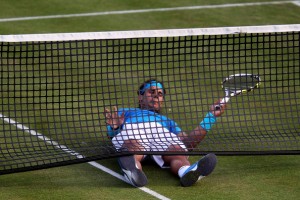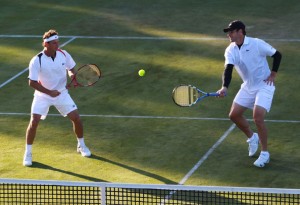Of all the tournaments huddled in the shadows of the majors, Queens and Halle are in the most awkward position, as are the top players around whom these events are currently marketed.  In part this owes to Wimbledon commencing only two weeks after Roland Garros ends, although it owes something to the two most dominant players of the era developing a taste for the Channel Slam.
In part this owes to Wimbledon commencing only two weeks after Roland Garros ends, although it owes something to the two most dominant players of the era developing a taste for the Channel Slam.
The last man with such tastes was Bjorn Borg, who achieved it no fewer than 27 times, if memory serves. Since his retirement it fell rather out of fashion for a few decades, until Rafael Nadal broke Roger Federer’s heart by taking away his most treasured bit of silverware, and then biting it. Since 2008 however, the whole thing has become decidedly de rigeur. My two-year-old son has known nothing else, and my five-year-old daughter has only the dimmest memory of being hauled out of bed to celebrate Federer’s 2007 victory, though it will eventually resurface in therapy. When I explained to them at considerable length just how difficult a feat the Channel Slam is – in a presentation heavy on flowchart and graph – they merely stared back blankly. Point made.
In any case, you don’t have to win the French and Wimbledon to find their juxtaposition wearying. Roland Garros can prove sufficiently gruelling even for the quarter-finalists, as attested to by a dinged-up Fabio Fognini, or even for the fans. The upshot of these considerations is that both Halle and Queens have compelling reasons for withdrawals coming at them from both directions. An exhausted French Open finalist is likely to be, well, exhausted, while an injured one will be unwilling to risk pressing the issue so close to Wimbledon.
This precisely describes the situation with Federer this week, whose form in Paris was impressive, but not so impressive that he could breeze through the final two rounds unscathed. He spent a long time on court last week, attacking the sport’s two greatest defenders on the sport’s slowest surface. In doing so he apparently sustained a minor groin injury, and, having decided that idleness is the better part of prudence, he has pulled out of Halle.  Halle’s tournament director was livid, but really he must have seen it coming, as last Sunday’s final entered its fourth hour. Federer, who has won Halle five times already, might rightfully point out that he owes them little, and that he stuffed his back there last year.
Halle’s tournament director was livid, but really he must have seen it coming, as last Sunday’s final entered its fourth hour. Federer, who has won Halle five times already, might rightfully point out that he owes them little, and that he stuffed his back there last year.
Regardless, the proximity to Wimbledon, and the criminally short grass court season, mean that both Queens and Halle command far better fields than any comparable event slotted the week after a major. Players boasting meagre grass court credentials will turn up even while injured, since they need all the exposure they can get. Djokovic and Federer notwithstanding, just about everyone has fronted up.
Happily, both tournaments have thus far bucked the season’s prevailing fashion for an early and massive seed-haemorrhage. The seeds have mostly fared well. Two rounds in, and last night pulled out the best line-up of matches shy of a good Masters event. Sadly, few of the matches lived up to their billing, but you can’t have everything. Nalbandian – Verdasco fizzed, as did Kohlschreiber – Dolgopolov. Del Potro was upset, and Nadal dropped a set and fell over against Stepanek. The most impressive player was Gael Monfils. On Grass. In Germany. Who saw that coming?
Tonight’s line up looks even better.
